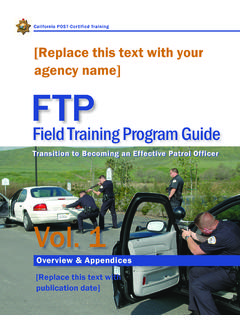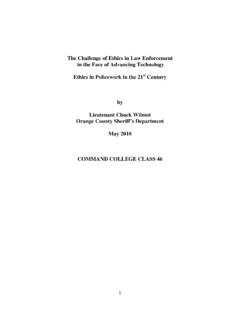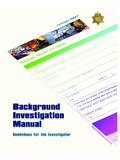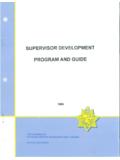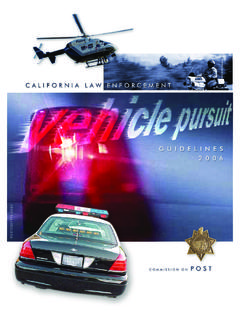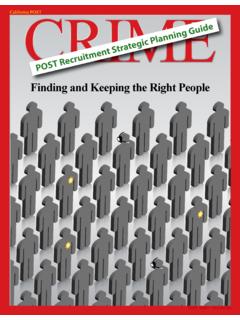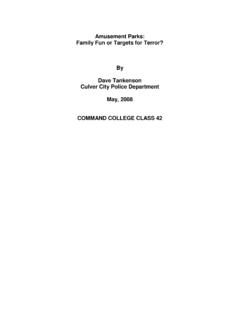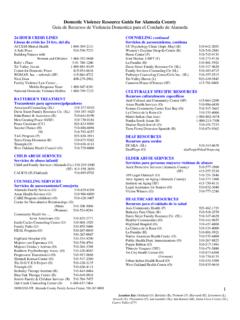Transcription of POST Guidelines - Crowd Management, …
1 POST Guidelines Crowd management , Intervention, and ControlCALIFORNIA COMMISSION ON PEACE OFFICER STANDARDS AND TRAININGF orward byPaul CappitelliExecutive DirectorCommission on Peace Officer Standards and Training POST GuidelinesCrowd management , Intervention, and ControlPOST Guidelines Crowd management , Intervention, and Control 2012 by California Commission on Peace Officer Standards and TrainingPublished March 2012 All rights reserved. This publication may not be reproduced, in whole or in part, in any form or by any means electronic or mechanical or by any information storage and retrieval system now known or hereafter invented, with out prior written permission of the California Commission on Peace Officer Standards and Training, with the following exception: California law enforcement agencies in the POST peace officer program and POST-certified training presenters are hereby given permission by POST to reproduce any or all of the contents of this manual for their internal other individuals, private businesses and corporations, public and private agencies and colleges, professional associations, and non-POST law enforcement agencies in state or out-of-state may print or download this information for their personal use of the copyright protection law and the provisions expressed here and on the POST website under Copyright/Trademark Protection will be pursued in a court of law.
2 Questions about copyright protection of this publication and exceptions may be directed to Publications image from shalunts / Guidelines Crowd management , Intervention, and Control | iPOST Mission StatementThe mission of the California Commission on Peace Officer Standards and Training is to continually enhance the professionalism of California law enforcement in serving its blankPOST Guidelines Crowd management , Intervention, and Control | iiiPOST CommissionersChairLai Lai Bui Detective, sacramento police DepartmentVice ChairJim McDonnell Chief, Long Beach police DepartmentWalter Allen Member, Covina City CouncilTom Anderson Public MemberRobert Cooke Special Agent in Charge California Narcotic Officers AssociationFloyd Hayhurst Deputy Sheriff, Los Angeles CountyRon Lowenberg Director, Criminal Justice Training Center Golden West CollegeJohn McGinness Sheriff (Retired), sacramento CountyMichael A.
3 Ramos District Attorney, San Bernardino CountyMichael Sobek Sergeant, San Leandro police DepartmentKamala D. Harris Attorney General, Ex Officio MemberPaul Cappitelli Executive DirectorIntentionally blankPOST Guidelines Crowd management , Intervention, and Control | vGuidelines Development CommitteeDennis Beene Deputy Chief California Emergency management AgencyKen Bernard Captain sacramento police DepartmentDon Bradley Chief Deputy Santa Cruz County Sheriff s OfficeDonald Buchanan Commander Alameda County Sheriff s OfficeRobert Fonzi Assistant Sheriff San Bernardino County Sheriff s DepartmentRobert Gerber Acting Chief California Emergency management AgencyBob Green Commander Los Angeles police DepartmentPaul Henisey Chief UC Irvine police DepartmentMichael Hillmann Deputy Chief (Ret.) Los Angeles police DepartmentD. R. Ike Iketani Assistant Chief California Highway PatrolRoxana Kennedy Lieutenant Chula Vista police DepartmentBoyd Long Assistant Chief San Diego police DepartmentBruce Naliboff Chief Investigator Yolo County District Attorney s OfficePatrick O Neill Sergeant Eureka police DepartmentNader Oweis Chief UC Santa Cruz police DepartmentMichael Peters Lieutenant Orange County Sheriff s DepartmentEugene Ramirez Attorney Manning & Kass, Ellrod, Ramirez, and Trester LLPC arol Ann Rohr Deputy City Attorney City of Santa MonicaTom Schwedhelm Chief Santa Rosa police DepartmentRobert Smith Senior Consultant POSTErik Upson Captain Berkeley police department Robert Wickum Captain San Bernardino County Sheriff s DepartmentRobert Wren Lieutenant Orange County Sheriff s DepartmentIntentionally blankPOST Guidelines Crowd management , Intervention.
4 And Control | viiForwardPenal Code requires the Commission on Peace Officer Standards and Training to establish Guidelines and training for law enforcement s response to Crowd management . It specifies that the Guidelines to be developed by the commission should take into consideration the roles and responsibilities of all law enforcement officers responding to acts of civil disobedience. These Guidelines provide information for law enforcement agencies to consider when addressing the complexities and broad range of issues related to Crowd management . For the purposes of these Guidelines , the general term Crowd management encompasses the management , intervention, and control strategies for a law enforcement response to public assemblies and gatherings that can range from peaceful/non-violent to unlawful and riotous. The Guidelines are not meant to constitute policy, nor are they intended to establish a statewide standard.
5 They are solely a resource for law enforcement leaders to provide foundational guidance for the facilitation of First Amendment rights while allowing discretion and flexibility in the development of individual agency policies. The information contained in this publication represents the best thinking of contemporary law enforcement leadership. POST is grateful for the assistance of the Guidelines Development Committee who generously gave of their time and expertise. Questions or comments concerning these Guidelines should be directed to the POST Training Program Services Bureau at 916 CappitelliExecutive DirectorCommission on Peace Officer Standards and Training Intentionally blankPOST Guidelines Crowd management , Intervention, and Control | ixIntroductionIn the United States all people have the right of free speech and assembly guaranteed by the First Amendment of the Constitution. The First Amendment states Congress shall make no law respecting an establishment of religion, or prohibiting the free exercise thereof; or abridging the freedom of speech, or of the press; or the right of the people peaceably to assemble, and to petition the Government for a redress of grievances.
6 A fundamental role of law enforcement is the protection of the rights all people have to peacefully assemble, demonstrate, protest, or rally. In turn, law enforcement also has the responsibility to ensure public safety and to protect the lives and property of all people. The sometimes competing goals of maintaining order while protecting the freedoms of speech and assembly stand as one of law enforcement s greatest challenges. These Guidelines are designed to assist law enforcement leadership in addressing the many challenges and broad range of issues surrounding a response to incidents of Crowd management . All law enforcement leaders should familiarize themselves with the Guidelines , strategies, terms, and definitions set forth in this document. These are the generally accepted principles of Crowd management , intervention and control, and should serve to guide a law enforcement agency s response to both lawful and unlawful assemblies.
7 Law enforcement planners should be proactive in consulting with and advising their jurisdiction s elected and administrative leaders of the identified strategies and plans for specific events. Such interactions will help establish responsibility and accountability at all levels. Intentionally blankPOST Guidelines Crowd management , Intervention, and Control | xiContentsPOST Mission Statement ..iPOST Commissioners ..iiiGuidelines Development Committee ..vForward ..viiIntroduction ..ixPart 1 Law Enforcement Objectives ..1 Guideline Law Enforcement Objectives in the 21st Century ..1 Guideline Principles of Crowd management ..3 Guideline Community Stakeholders ..5 Part 2 Planning and Preparation ..7 Guideline Incident Command System (ICS) and Standardized Emergency management Systems (SEMS) ..7 Guideline Incident/Event Planning ..9 Guideline Crowd Behavior ..13 Guideline Mutual Aid & Multi-Agency Coordination.
8 15 Guideline Public Agency and Community-Based Resources ..17 Guideline Training for Managing Crowds ..19 Part 3 Information management ..21 Guideline Information Gathering and Assessment ..21 Guideline Incident Documentation ..23 Part 4 Roles and Responsibilities ..25 Guideline Command and Control ..25 Guideline Leadership Responsibilities ..27 Guideline Criminal Investigation ..29 Part 5 Crowd Control ..31 Guideline Crowd management , Intervention, and Control Strategies ..31 Guideline Dispersal Mass Arrests and Bookings ..35 Guideline Use of Force: Force Options ..39 Guideline Use of Nonlethal Chemical Agents ..41 Part 6 Media ..43 Guideline Media Strategies ..43 Guideline Electronic Communication and Social Media ..45 Appendix A Terms and Definitions ..47 Appendix B Crowd management Intervention and Control Strategies ..51 Appendix C Applicable Statutes.
9 53 Appendix D Applicable Case Law ..57 Appendix E Training and Information Resources ..61 Intentionally blankPOST Guidelines Crowd management , Intervention, and Control | 1PA RT 1 Law Enforcement Objectives Discussion: Law enforcement must carefully balance the First Amendment rights and other civil liberties of individuals with the interventions required to protect public safety and property. When establishing policies and procedures, every agency should consider that all persons have the right to assemble, demonstrate, protest, rally, or perform other activities protected by the First Amendment of the United States Constitution. Law enforcement has the responsibility to protect the lives and property of all people. Peace officers must not be affected by the content of the opinions being expressed nor by the race, gender, sexual orientation, physical disabilities, appearances, religion, or political affiliation of anyone exercising their lawful First Amendment rights.
10 They must have the integrity to not let personal, political, or religious views affect how they perform their duties. Law enforcement planners should be proactive in consulting with and advising their jurisdiction s elected and administrative leaders of the identified strategies and plans for specific events. Such interactions will help establish responsibility and accountability at all levels. Issues to consider (not in priority order): Protection of Constitutional rights Fair and impartial enforcement of laws Protection of life and property Protection of vital facilities Prosecution of violators Public and peace officer safety Potential for disruption to commerce and community affairsEstablish policies and procedures that recognize and address law enforcement objectives and provide for the legal protection of the Constitutional rights of all persons. Guideline Law Enforcement Objectives in the 21st CenturyGuidelineIntentionally blankPOST Guidelines Crowd management , Intervention, and ControlPA R T 1 Law Enforcement Objectives | 3 Discussion: Any public assembly or gathering, whether for lawful or unlawful purposes, may require the response of law enforcement.
